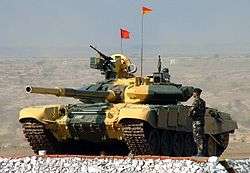Uralvagonzavod
 UralVagonZavod headquarters in Nizhny Tagil, SVE | |
Native name | УралВагонЗавод |
|---|---|
| Public limited company | |
| Industry | Machine building |
| Founded | 1936 |
| Headquarters | Nizhny Tagil, SVE, Russia |
| Products | Tanks, vehicles, metallurgical products |
| Revenue |
|
|
| |
| Website |
www |
Uralvagonzavod (UVZ) is a Russian machine building company located in Nizhny Tagil, Russia. It is one of the largest scientific and industrial complexes in Russia[1] and the largest main battle tank manufacturer in the world.[2]
The full name of the company is "Open Joint Stock Company “Research and Production Corporation “Uralvagonzavod”" (ОАО «Научно-производственная корпорация «УралВагонЗавод»). It is a public limited company. The name Уралвагонзавод means Ural Railroad Car Factory.
History
The plant was built during 1931-1936 (mostly during the second five-year plan), launched on October 11, 1936, and named after Felix Dzerzhinsky. Initially it manufactured freight cars.
After the German invasion of 1941, Stalin ordered hundreds of factories in Ukraine and western Russia to be evacuated east. The KhPZ Factory No. 183 in Kharkiv was moved to Nizhny Tagil by rail, and merged with the Dzerzhinsky Works, to form the Stalin Ural Tank Factory No. 183. During the second world war it became the largest producer of tanks in the world, including the T-34. After the war, tank production was scaled down, and part of the Vagonka's manufacturing and design assets were transferred back to Kharkiv's Diesel Factory No. 75 during 1945–51.
After the war it was expanded to produce machinery of other destinations: agricultural, construction, aviation, and space, including design and production of the Vostok, Voskhod, Proton and Energia expendable rockets.
It is the location of the Kartsev-Venediktov Design Bureau (OKB-520) where the T-54A and T-55 (development of Morozov's T-54), T-62, T-72, and T-90 tanks have been designed, and was working on one possibility for a next generation main battle tank, rumored to be called the T-95, until this project was cancelled in May 2010.
Its gradual privatization was planned, beginning in 2006.
Operations
The company's main products include railway cars, tanks, road-building vehicles, agricultural vehicles, metallurgical products, tools and consumer goods.[1]
Production of T-90 main battle tanks accounts for 18–20% of the company's overall production.[3] In 2008, Uralvagozavod produced about 175 tanks: 62 T-90A for the Russian Ministry of Defence, 60 T-90S for India .[2] This represents the highest level of tank production at Uralvagonzavod and in Russia as a whole since 1993. Moreover, according to Moscow Defense Brief, it would appear that in 2008 the number of tanks produced by the company was greater than the number of main battle tanks produced in all the other countries of the world taken together.[2]
Railway cars and other civilian production amounted to 2/3 of the company's overall output in 2008.[4]
In 2011, the company's revenue was $3 billion, and net profit was $0.33 billion.[5]
-

Uralvagonzavod tram at Innoprom industrial exhibit
-

Indian Army T-90
-

The main Uralvagonzavod building
References
- 1 2 "Uralvagonzavod". Globalsecurity.org. Retrieved 2009-05-19.
- 1 2 3 Barabanov, Mikhail. "Russian Tank Production Sets a New Record". Moscow Defense Brief (Moscow: Centre for Analysis of Strategies and Technologies).
- ↑ Makienko, Konstantin. "Economic Crisis and Russia’s Defense Industry". Moscow Defense Brief (Centre for Analysis of Strategies and Technologies) (#1(15)/2009). Retrieved 2009-05-19.
- ↑ "What the Russian papers say". RIA Novosti. 2009-01-07. Retrieved 2009-07-01.
- ↑ "UVZ investor relations". 2012-07-19.
External links
| Wikimedia Commons has media related to Uralvagonzavod. |